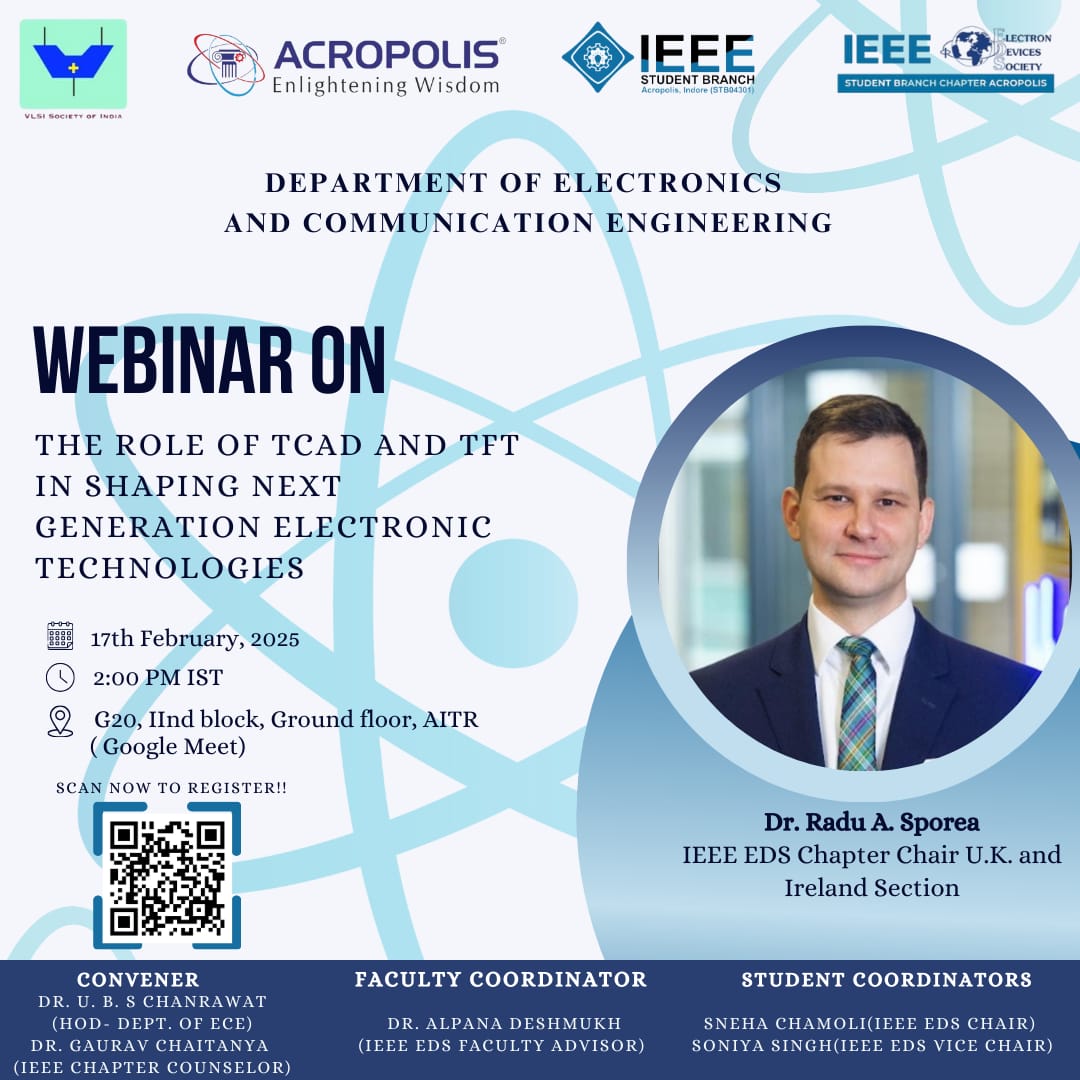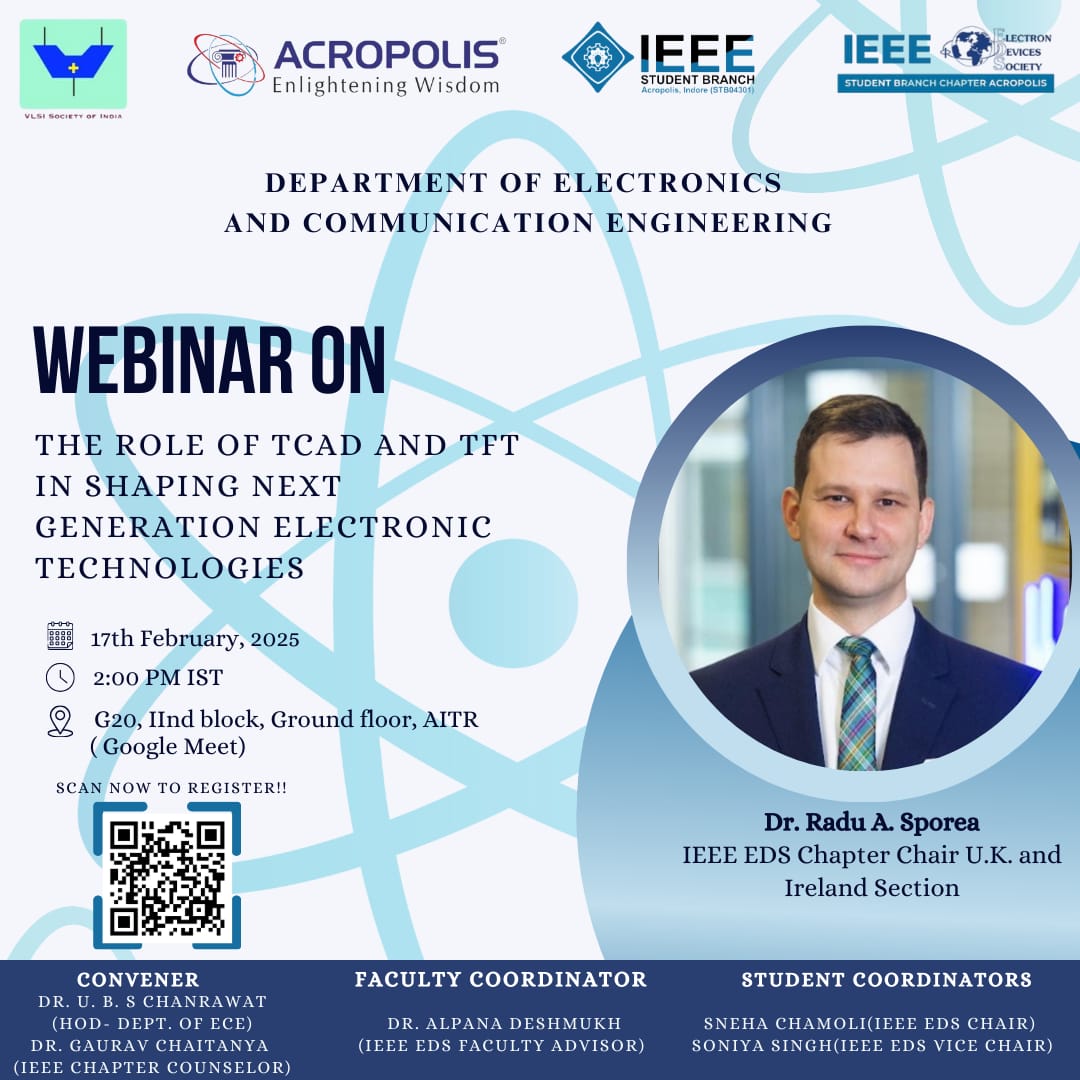The Role of TCAD and TFT in Shaping next generation Electronic technologies
AITR Indore, MP, India
TCAD refers to a suite of simulation and modeling tools used to design, optimize, and analyze semiconductor devices before physical fabrication. It integrates process simulation, device simulation, and circuit modeling to enhance efficiency and reduce development costs. TFTs are field-effect transistors (FETs) fabricated using thin-film semiconductor layers deposited on substrates such as glass, plastic, or flexible materials. They are widely used in display technologies and flexible electronics.
Date and Time
Location
Hosts
Registration
- Date: 17 Feb 2025
- Time: 02:00 PM to 03:00 PM
- All times are (UTC+05:30) Chennai
-
 Add Event to Calendar
Add Event to Calendar
- Contact Event Host
- Co-sponsored by Department of Electronics and Communication Engineeering
- Starts 10 February 2025 12:00 AM
- Ends 17 February 2025 12:00 AM
- All times are (UTC+05:30) Chennai
- No Admission Charge
Speakers
DR. RADU SPOREA of University of Surrey, London UK
THE ROLE OF TCAD AND TFT IN SHAPING NEXT GENERATION ELECTRONIC TECHNOLOGIES
1. Technology Computer-Aided Design (TCAD) and Its Role
What is TCAD?
TCAD refers to a suite of simulation and modeling tools used to design, optimize, and analyze semiconductor devices before physical fabrication. It integrates process simulation, device simulation, and circuit modeling to enhance efficiency and reduce development costs.
Key Contributions of TCAD:
- Accelerating Innovation: TCAD helps predict device performance and reliability before fabrication, reducing trial-and-error in manufacturing.
- Optimizing Semiconductor Devices: Used extensively in optimizing FinFETs, MOSFETs, and next-generation transistor architectures such as Gate-All-Around FETs (GAAFETs).
- Reducing Costs & Time-to-Market: Enables virtual prototyping, minimizing expensive experimental iterations.
- Advanced Materials & Process Development: Facilitates the integration of novel materials like 2D semiconductors, III-V compounds, and high-k dielectrics.
- Reliability & Failure Analysis: Helps in predicting aging, leakage currents, and thermal effects, improving device longevity.
Applications of TCAD:
- CMOS and Advanced Transistor Design (e.g., FinFETs, GAAFETs, and 2D material-based transistors)
- Power Electronics (e.g., SiC & GaN-based devices for high efficiency)
- Flexible and Wearable Electronics
- Optoelectronics (e.g., OLEDs, microLEDs, photonic devices)
2. Thin-Film Transistors (TFTs) and Their Role
What are TFTs?
TFTs are field-effect transistors (FETs) fabricated using thin-film semiconductor layers deposited on substrates such as glass, plastic, or flexible materials. They are widely used in display technologies and flexible electronics.
Key Contributions of TFTs:
- Flexible & Wearable Electronics: TFTs enable bendable and stretchable electronics, driving the development of next-gen flexible displays, e-paper, and smart textiles.
- High-Performance Displays: Used in LCDs, OLEDs, and microLED panels to control pixel switching and improve refresh rates.
- Low-Power IoT Devices: Advanced TFTs are essential for low-power sensor arrays in smart cities and healthcare applications.
- Integration with Novel Materials: TFTs are increasingly developed using oxide semiconductors (e.g., IGZO) and organic semiconductors, expanding their applications beyond traditional silicon-based electronics.
Applications of TFTs:
- Smartphone & TV Displays (LCD, OLED, microLED)
- Flexible Electronics & E-paper Displays
- Wearable Health Monitoring Devices
- Transparent & Printable Electronics
- Large-Area Sensors & RF Devices
3. Synergy Between TCAD and TFTs
How TCAD Enhances TFT Development:
- Process Optimization: TCAD simulations help improve TFT fabrication methods by refining deposition processes and annealing conditions.
- Performance Prediction: Allows for the study of mobility, leakage currents, and switching speeds before mass production.
- Material Engineering: Enables exploration of alternative semiconductors (e.g., IGZO, graphene, perovskites) for TFTs.
- Reliability Enhancement: Predicts device degradation and helps in developing self-healing or long-lifespan TFTs.
Future Trends & Challenges:
- AI & Machine Learning Integration: AI-driven TCAD tools will accelerate material discovery and device optimization.
- Hybrid & 3D Architectures: Combining TFTs with emerging nanoelectronics (e.g., neuromorphic computing, memristors) for AI hardware.
- Sustainability & Energy Efficiency: Research on low-power TFTs for energy-harvesting applications.
Biography:
Dr Radu Sporea is Associate Professor in Semiconductor Devices at the University of Surrey, and holds an EPSRC Early Career Fellowship (2021-2026). He was RAEng Research Fellow (2011-2016), EPSRC PhD+ Fellow (2010-2011) and PhD researcher (2006 – 2010). Radu studied Computer Systems Engineering at “Politehnica” University, Bucharest, and worked as Design Engineer for Catalyst Semiconductor Romania on ultra-low-power CMOS analog circuits. Radu was named EPSRC Rising Star in 2014 and received the I K Brunel Award for Engineering in 2015, the Vice Chancellor’s award for Early Career Teaching in 2017 and the Tony Jeans Inspirational Teaching distinction in 2018. In 2021, he was a finalist for Innovator of the Year prize at Surrey. His research focuses on advanced thin-film transistors for improved manufacturability, large area sensors and sensor arrays for smart environments, and paper-based electronics and physical-digital interaction. He is chair of the IEEE EDS UK and Ireland chapter.
Email:
Address:Advanced Technology Institute School of Computer Science and Electronic Engineering University of Surrey, , London, United Kingdom
Agenda
Department of Electronics and Communication Engg. (IEEE EDS SB)


